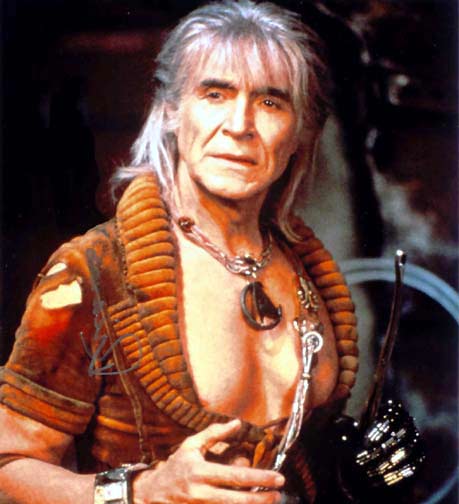It is a doubtless proposition that The Wrath of Khan simply is the best movie ever made. This is one of the formative facts of our present day universe. Our world would not be as it is if the truth of that statement were otherwise. That being said, I'm outrageously excited to finally have made our way to episode 23, the set-up to Khan's circumstances as found in the movie. That's right, then, based on what we know from the movie, it will have to be the case that in the episode "Space Seed" we will be forced to face a human superhero, an engineered ultra-intellect capable of persuading the devotion of all those like him, with the power to (temporarily at least) take over all of humanity. Khan is that super man.
Part of the excellence of this episode is that Khan is played by the same man in both this episode and the movie. It's such a beautiful, luscious fact of the Star Trek universe that Ricardo Montalban fully inhabits Khan. His vicious brilliance is played by only one man.
 Khan's brilliance as seen in The Wrath of Khan
Khan's brilliance as seen in The Wrath of Khan When The Wrath of Khan was filmed, Montalban was 62-years of age, and sporting one of the most impressive chests in Hollywood. Many people assumed that his character's prowess was fulfilled with some sort of synthetic prothetic; that is, stage makeup. No. No. No. Khan is better than that. Montalban did Brad Pitt from Troy two decades better. Pitt faced age 40 with the filming of the overly long Greek drama and so took on the milestone by putting his body in the best shape of his life that far. Montalban trained for his part as well. But he did so 2 decades and 2 years greater than Pitt, and you can see the strength of his 62-year old self already present in his early rendition of the same character in the episode "Space Seed." At the filming of the episode, Montalban was 47, sporting the same impressive pectoral muscles, though not yet showing the gorgeous gray hair of his movie self.
 Khan as seen in the episode "Space Seed"
Khan as seen in the episode "Space Seed"One of the thrills of this episode is that it introduces us to the character who is widely considered one of the best sci-fi villans of all time. In this episode we also get to experience an expansion of the possibilities imagined by the Star Trek understanding of science fiction. Here we discover that humans can be engineered, genetics can be altered and predicted, and that in such a design process things can go terribly wrong. In this way, "Space Seed" anticipates much of the biomedical ethical concerns brewing in both pop culture and academic circles today around the idea of our producing something like "designer babies." Khan is our warning. The premise is this: Okay, let's imagine you could produce a genetically superior, pre-planned for desired attributes human being. The question becomes: and, now with that ability, what about such planning and design do you not know how to control or predict?
In this way, Roddenberry returns to a different rendition of an earlier concern. When you mess with what humans are and the abilities they already have, you might be getting problems you don't bargain for. In this way, it turns out Star Trek gives us an illustration of Hannah Arendt's point--the more developed and powerful our technology becomes, the less control we have over it's impact in our lives when we use it. Arendt's point, it turns out, stands even when that technology is used to produce ourselves.
Episode Summary
According to the Star Trek timeline, Earth suffered under what they refer to as "The Eugenic Wars" in the 1990's. Hmm. Sound familiar? The original Enterprise, of course, dates us to the year 2267.
In the midst of ordinary space exploration, Kirk and the crew encounter an undocumented, and deteriorating ship floating in space--the U.S.S. Botany Bay. They discover it to be a cryogenic ship containing 72 frozen, though still alive passengers. Initially, Spock is unsure if the passengers are actually human. But upon further exploration the crew is forced to rescue the man found inside one of the cryogenic tubes, as the tube's life support system appears to be failing. Taken back aboard the Enterprise, the man is revived, though apparently still unconscious. Bones promises Kirk they can question the man once he has fully recovered, and then suddenly we discover the doctor with a scalpel held to his jugular. The man has awoken, and attacked his doctor. And so we meet Khan.
Meanwhile, Spock determines the history of the Botany crew. Khan is the leader of a group of people that were all the result of the Eugenic wars. They were bred to serve as perfect soldiers in the fight between different human factions. The perfect soldiers, however, weren't just designed to have excellent fighting capacities, it turns out they were engineered so that those fighting abilities arose out of super intelligence too. Eventually the soldiers were no longer willing to fight for the sake of someone else and rose up against the military forces that had been exploiting them. The men became warlords and dominated a third of the planet Earth, with Khan as their leader.
With his brilliance, Khan works to take over the Enterprise, reviving his men on the Botany Bay to do so. Suddenly Kirk is faced with a truly formidable enemy. As we know from the movie, Kirk eventually outpaces Khan and exiles he and his fellow genetically engineered peoples to Ceti Alpha V, a hospitable planet fully capable of supporting excellent life, until its unfortunate fate (as discovered through the movie) shows Khan and his people otherwise.
Khanian Influence
We can see the influence of the Khan storyline in other science fiction movies. I'll venture to claim that the story of Roy Batty, Rutger Hauer's character in Blade Runner, bears an ethical resemblance to the Khan situation. In both cases the question is being asked--what happens when our engineered creation seems to develop a life of its own? In each case, interestingly, the answer is that we must isolate the creation from us humans. It would appear that such a response is justified since in both cases the engineered humans present themselves as violent. From one perspective the violence would seem to demand we respond with violence, finally isolating them from humanity. From another perspective it would seem that the characters' calls to violence are the only option they are given through which they might gain any possibility of recognition for who and what they are--genuinely alive. We could point out that Khan is an engineered human, while Batty is an engineered replicant (that is--fully engineered). However, it would seem that the ethical concern remains the same both situations. The point is that in either case the subject has become just that--a living, experiencing being.
We can also see that the idea of engineered humans rises again with Julian Bashir, the chief medical officer in Deep Space Nine. (Thank god! It's the one moment when Bashir finally presents himself as interesting.) The question of engineered creations becoming a living being also shows itself in The Next Generation when Data goes to trial to fight for inalienable rights of self-determination.
As a quick sidenote, I'll also point out that the way in which Khan and his engineered comrades are discussed has a remarkable resemblance to how our present day U.S. media and former president's government described tribal leaders in Afghanistan.
In this way, Roddenberry returns to a different rendition of an earlier concern. When you mess with what humans are and the abilities they already have, you might be getting problems you don't bargain for. In this way, it turns out Star Trek gives us an illustration of Hannah Arendt's point--the more developed and powerful our technology becomes, the less control we have over it's impact in our lives when we use it. Arendt's point, it turns out, stands even when that technology is used to produce ourselves.
Episode Summary
According to the Star Trek timeline, Earth suffered under what they refer to as "The Eugenic Wars" in the 1990's. Hmm. Sound familiar? The original Enterprise, of course, dates us to the year 2267.
In the midst of ordinary space exploration, Kirk and the crew encounter an undocumented, and deteriorating ship floating in space--the U.S.S. Botany Bay. They discover it to be a cryogenic ship containing 72 frozen, though still alive passengers. Initially, Spock is unsure if the passengers are actually human. But upon further exploration the crew is forced to rescue the man found inside one of the cryogenic tubes, as the tube's life support system appears to be failing. Taken back aboard the Enterprise, the man is revived, though apparently still unconscious. Bones promises Kirk they can question the man once he has fully recovered, and then suddenly we discover the doctor with a scalpel held to his jugular. The man has awoken, and attacked his doctor. And so we meet Khan.
Meanwhile, Spock determines the history of the Botany crew. Khan is the leader of a group of people that were all the result of the Eugenic wars. They were bred to serve as perfect soldiers in the fight between different human factions. The perfect soldiers, however, weren't just designed to have excellent fighting capacities, it turns out they were engineered so that those fighting abilities arose out of super intelligence too. Eventually the soldiers were no longer willing to fight for the sake of someone else and rose up against the military forces that had been exploiting them. The men became warlords and dominated a third of the planet Earth, with Khan as their leader.
With his brilliance, Khan works to take over the Enterprise, reviving his men on the Botany Bay to do so. Suddenly Kirk is faced with a truly formidable enemy. As we know from the movie, Kirk eventually outpaces Khan and exiles he and his fellow genetically engineered peoples to Ceti Alpha V, a hospitable planet fully capable of supporting excellent life, until its unfortunate fate (as discovered through the movie) shows Khan and his people otherwise.
Khanian Influence
We can see the influence of the Khan storyline in other science fiction movies. I'll venture to claim that the story of Roy Batty, Rutger Hauer's character in Blade Runner, bears an ethical resemblance to the Khan situation. In both cases the question is being asked--what happens when our engineered creation seems to develop a life of its own? In each case, interestingly, the answer is that we must isolate the creation from us humans. It would appear that such a response is justified since in both cases the engineered humans present themselves as violent. From one perspective the violence would seem to demand we respond with violence, finally isolating them from humanity. From another perspective it would seem that the characters' calls to violence are the only option they are given through which they might gain any possibility of recognition for who and what they are--genuinely alive. We could point out that Khan is an engineered human, while Batty is an engineered replicant (that is--fully engineered). However, it would seem that the ethical concern remains the same both situations. The point is that in either case the subject has become just that--a living, experiencing being.
We can also see that the idea of engineered humans rises again with Julian Bashir, the chief medical officer in Deep Space Nine. (Thank god! It's the one moment when Bashir finally presents himself as interesting.) The question of engineered creations becoming a living being also shows itself in The Next Generation when Data goes to trial to fight for inalienable rights of self-determination.
As a quick sidenote, I'll also point out that the way in which Khan and his engineered comrades are discussed has a remarkable resemblance to how our present day U.S. media and former president's government described tribal leaders in Afghanistan.






No comments:
Post a Comment